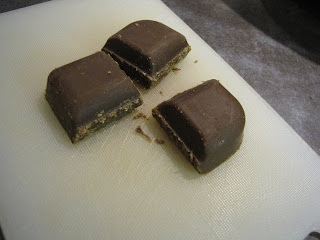
I adore a hearty bowl of oatmeal in the morning for breakfast. The great thing about oatmeal (besides its fabulous nutritional value) is its flexibility. You can spice it up whatever way you like. Creativity makes a wonderful breakfast!
Now in this photo I have posted, I used steel-cut oats, canned pumpkin, pumpkin pie spice, raisins and Splenda sweetener. It doesn't really look like much, but let me say it tasted more like a guilty pleasure than a super high fiber breakfast! Actually, I made a big pot of this particular flavour and froze it into individual containers. Steel-cut oatmeal freezes very well. You can purchase individual portions of cooked steel-cut oats from the frozen foods aisle of grocery stores, but it is much cheaper to make it yourself. Steel-cut oats do take more time to cook than their instant counterparts, but there are ways around this. Cooking oats does not require a lot of attention, other than making sure it does not boil over. So I cooked this batch while I was already cooking supper. I was in the kitchen and had a free burner, so why not? Three cups of water to one cup of steel-cut oats will make four servings of oatmeal. As this batch was cooking, I added one small can of pure pumpkin (not pumpkin pie filling...just pure pumpkin). A dash of pumpkin pie spice then went in, as well as some Splenda and raisins. When I serve this delight to myself (my husband is not an oatmeal fan), I gently reheat it and add a splash of milk. Simple, healthy and delicious!
Now many may wonder why I keep specifying "steel-cut oats". I never knew the full delight of oatmeal until I had these! I used to make my oatmeal using the quick cooking variety widely available. The quick cooking and instant types are great for baking and for mornings when you need breakfast fast. However, every once in a while, we should indulge in the pleasure of the slow cooking variety. The wheat kernel is sliced thinly for quick oats, but only cut in half for steel-cut. The result is a chewier, nuttier texture. I highly recommend trying it, if all you've ever had is instant or quick cooking. A properly prepared bowl of oatmeal cooked with just the right amount of flavour can really give you a boost on a dark early morning!
Ideas for Oatmeal
Add dried fruit (cherries, blueberries, cranberries etc)
Add slivered nuts and seeds (almonds, walnuts, sesame seeds etc)
Choose your sweetener (brown sugar, white sugar, honey, splenda, Maple syrup)
Add dairy or other liquid (milk, cream, soymilk, yogurt)
Spice it up! (cinnamon, nutmeg, allspice, pumpkin pie spice)


























